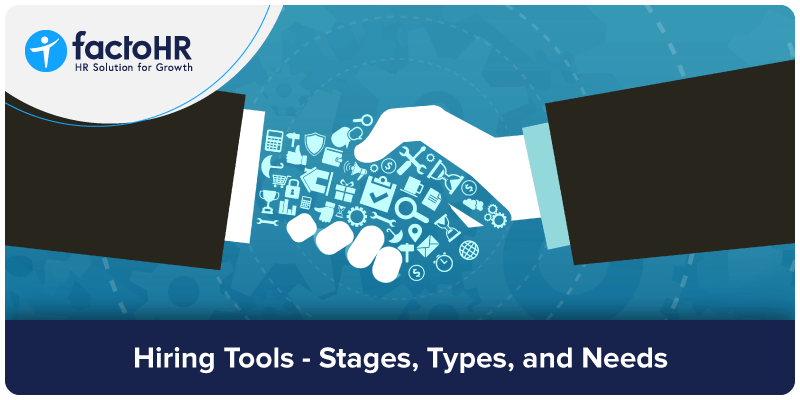Hiring Tools - Stages, Types, and Needs

Table of Contents
Finding the right candidates for a position can be tough, especially if you are relying on manual processes like reviewing and evaluating resumes and scheduling interviews. That’s where hiring tools can come in handy. These tools can streamline and improve various aspects of the hiring process, making it more efficient and effective.
What are the various stages of hiring
Hiring or recruitment is a sequential process which progresses through various stages.
Organisations typically have a 7-8 step recruitment process.
Job posting
This is when the organisation decides they need to hire someone new and creates a job posting to advertise the position.
Resume review
After the job posting goes live, candidates start sending in their resumes and applications. The organisation then goes through all these resumes to find the most qualified candidates.
Initial screening
Once there is a list of promising candidates, they’ll usually conduct some initial screenings, often through phone or video interviews. This helps narrow down the pool of applicants to the most promising candidates.
In-person interviews
The most promising candidates are then invited for in-person interviews, often with multiple team members or department heads. This is a chance for both sides to get to know each other better and see if the fit is right.
Skills assessment
Depending on the position, the organisation may also conduct skills assessments, such as aptitude tests or coding challenges, to further evaluate a candidate’s qualifications.
Reference checks
Before making a final decision, candidate’s references may be contacted to gather more information about their work history and skills.
Offer
If everything checks out and the organisation wants to hire the candidate, they’ll make a job offer, which may include negotiations over salary, benefits, and other terms.
Onboarding
Once the candidate has accepted the job and started working, the organisation may have an onboarding process to help them get up to speed and integrated into the company. Having onboarding software can speed up this leg of the recruitment process greatly.

What are different types of hiring tools available
There are a wide range of hiring tools available, each designed to help companies streamline and improve various aspects of the hiring process. Here are some examples of the different types of hiring tools:
Applicant tracking systems (ATS)
These are automated software that help manage and track job applications, resumes, and other hiring-related information. ATS can help organisations review and sort resumes, schedule interviews, and communicate with candidates.
Resume databases
These are online collections of resumes that can be searched by employers to find potential candidates for open positions. The search can be narrowed down based on several parameters. Resume databases can be helpful for organisations looking to expand their pool of potential candidates.
Video conferencing software
These tools allow to conduct remote interviews with candidates via video call. Video conferencing software can be especially useful for organisations with remote hiring needs or for conducting interviews during situations like the COVID-19 pandemic. Some of these software also have a recording option so that the interview can be shared with other decision makers. Zoom.us is a great tool for this purpose.
Skill assessment tools
These are technologies that can help assess a candidate’s skills and qualifications, such as aptitude tests, coding challenges, and personality assessments. Skill assessment tools can help make more informed hiring decisions.
Background check services
These services can help verify a candidate’s employment history, education, and other personal information. Background verification services can help ensure that they are hiring candidates with accurate and reliable information.
Human resources management systems
HRMS are software platforms that help manage various HR tasks, including creating and managing job offers, tracking employee performance, and managing benefits and payroll. HRMS can help streamline and automate various HR tasks, making them more efficient and effective. Some tools may also include features like employee self-service portals, time and attendance tracking, and performance evaluations. They can be especially helpful for organisations with a large number of employees or a complex HR process.
Scheduling tools
These tools can help schedule and coordinate interviews and other hiring-related events with multiple candidates and team members.
You can also find comprehensive recruitment software covering all of the above described functionality.
You can Also Read: Top 10 Job Portals in India 2024

Why do you need hiring tools
Employing recruitment tools has many advantages. From saving cost and time, to even creating a brand image, recruitment tools can help organisations big and small in several ways.
Time-saving
Hiring tools can automate various tasks, such as resume screening and scheduling interviews, saving time for HR professionals and hiring managers.
Improved candidate experience
Some hiring tools, such as applicant tracking systems, can provide a more streamlined and organised experience for candidates. This can lead to a better overall impression of the organisation and potentially improve the chances of attracting top talent.
Increased efficiency
By automating certain tasks and providing a central location for all hiring-related information, hiring tools can help streamline their hiring process and make it more efficient.
Greater accuracy
Some tools, such as skill assessment tools, can help organisations assess a candidate’s skills and qualifications accurately and objectively, without biases.
Improved administration
Hiring tools can help companies keep track of resumes, applications, and other hiring-related information in a central location, making it easier to stay organised and on top of the process. All the documentation of the hiring process is available for future reference too, if the need arises.

When should an organisation invest in hiring tools
There are several factors that an organisation might consider when deciding whether to invest in recruitment tools. Here are a few examples:
- If an organisation is planning to hire a large number of employees in a short period of time, hiring tools can be very helpful in streamlining the process and saving time.
- Hiring tools like skill assessment tools and resume databases can be useful in expanding the pool of potential candidates for companies finding it difficult to find the right candidates.
- Organisations having a complex hiring process with multiple stages and stakeholders, can leverage hiring tools that can help streamline and organise the process, making it more efficient and effective.
- Hiring remote workers or conducting remote interviews can be a pain. For companies planning to be involved in such activities, tools like video conferencing software can be very useful.
- An organisation should also consider its budget when deciding whether to invest in recruitment tools. While some tools can be expensive, they can also provide significant benefits in terms of time-saving and increased efficiency.

Conclusion
Consider adopting the tools as per your organisation’s requirement and wherever you see that the time and effort spent is disproportional to the outcome the activity produces. These tools help in streamlining the end-to-end hiring process by automating many manual tasks. This saves time and effort for the HR team, which can be well spent on more focused activities and strategizing.
Grow your business with factoHR today
Focus on the significant decision-making tasks, transfer all your common repetitive HR tasks to factoHR and see the things falling into their place.

© 2025 Copyright factoHR


